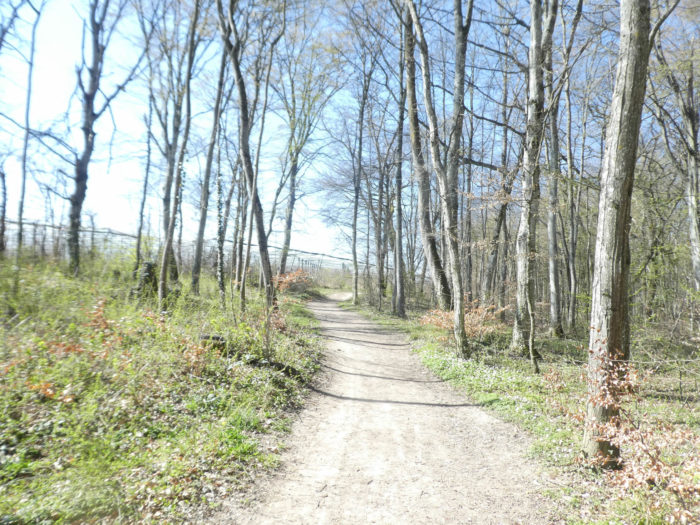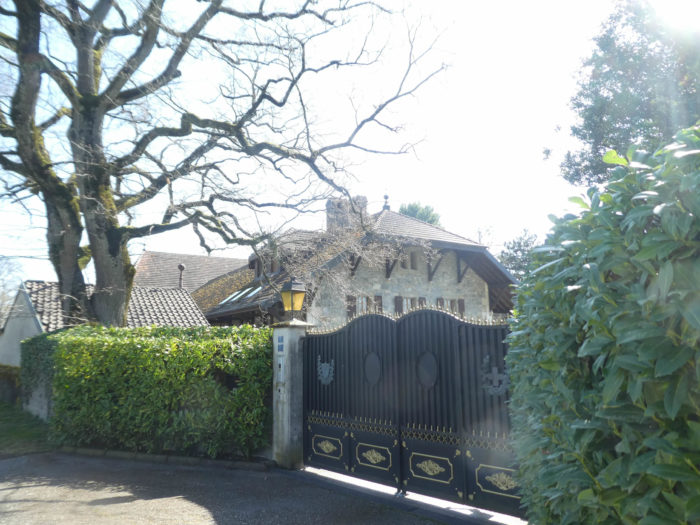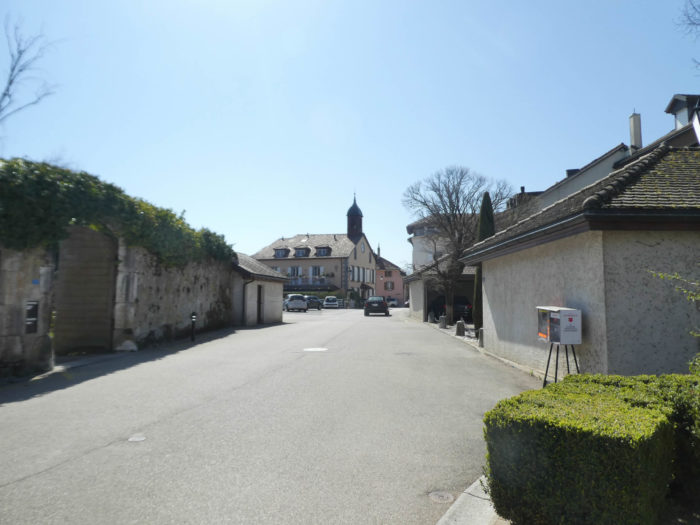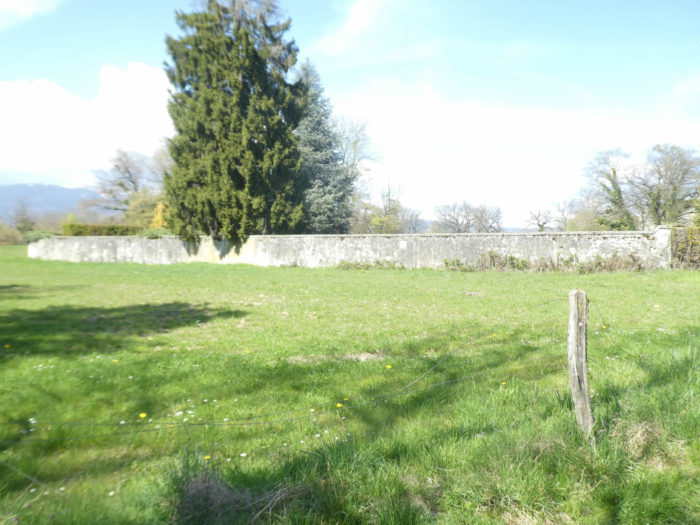The lake isn’t for everyone
DIDIER HEUMANN, ANDREAS PAPASAVVAS

We divided the course into several sections to make it easier to see. For each section, the maps show the course, the slopes found on the course, and the state of the route (paved or dirt roads). The courses were drawn on the « Wikilocs » platform. Today, it is no longer necessary to walk around with detailed maps in your pocket or bag. If you have a mobile phone or tablet, you can easily follow routes live.
For this stage, here is the link:
https://fr.wikiloc.com/itineraires-randonnee/de-rolle-a-coppet-par-la-via-jacobi-4-68572805
|
Not all pilgrims are necessarily comfortable using GPS or navigating routes on a mobile device, and there are still many areas without an internet connection. For this reason, you can find several books on Amazon dedicated to the major Via Jacobi 4 route, which runs through the heart of Switzerland and over the Brünig Pass. The first guide leads pilgrims through the German-speaking part of Switzerland up to Fribourg, while the second continues through French-speaking Switzerland to Geneva. We have also combined these two books into a compact, lighter, and highly practical version. While the descriptions have been slightly condensed, they remain detailed enough to guide you step by step along the way. Recognizing the importance of traveling light, this latest edition has been designed to provide only the essentials: clear and useful information, stage by stage, kilometer by kilometer. The stages have been carefully adjusted to ensure accessibility and alignment with available lodging options. These books go beyond simple practical advice. They guide you kilometer by kilometer, covering all the crucial aspects for seamless planning, ensuring that no unexpected surprises disrupt your journey. But these books are more than just practical guides. They offer a complete immersion into the enchanting atmosphere of the Camino. Prepare to experience the Camino de Santiago as a once-in-a-lifetime journey. Put on a good pair of walking shoes, and the path awaits you.
|

|
 |
The natural jewel that is the lake, with its mirror-like waters, should remain a welcoming land for all. There persists a belief, albeit naive, in legislation governing such matters. But alas, reality paints a different picture! A careful examination of the law, this aged sentinel erected in 1926, unequivocally reveals its intent: « On the shores of Lake Geneva, Lake Neuchâtel and Lake Morat, Lakes Joux and Brenet, as well as Lake Bret, it is imperative to preserve, along the shores and within a 2-meter strip, an area free from any construction or hindrance to free movement, in order to allow for the mooring of boats, the passage of boatmen and their assistants, as well as any other need related to navigation and fishing. » However, this law bows only to boatmen and fishermen, as owners of shores burdened by these constraints have the power to oppose any unauthorized intrusion onto their domains. The common folk often misconstrue the difference between a « stepping stone » and a « hiking trail ». Yet, there exists no law governing paths, in other words, the right of way for pedestrians along the lake shores. In simpler terms, the right of a stepping stone does not grant public access to private lands. The riverside path, on the other hand, must be materialized through the establishment of public passage easements, a domain reserved for municipalities and their dignitaries. Thus, from Lausanne to Rolle, some benevolent municipalities have generously granted expanded access to boatmen, fishermen, and strollers. While from Rolle to Geneva, other municipalities have preferred to promote the expansion of the affluent and their estates, a welcome source of substantial tax revenue, restricting public access to the lake as much as possible. All of this signifies that nowadays, gazing upon the lake from its shores has become the privilege of the heights. It goes without saying that no one entertains the idea of laying down petal-strewn paths for wanderers. For between economic realities and geopolitics, the stakes are manifold and complex. But the numerous weekend hikers are not far removed from sharing this sentiment.

Difficulty level : The gradients (+217 meters/-217 meters) are still laughably insignificant today. Come on! Let’s say it’s flat, almost always flat.
State of the Via Jacobi : Alas, it will be a nearly complete day on asphalt. What can you do? It’s a fairly dense population basin:
- Paved roads: 20.4 km
- Dirt roads : 9.5 km
Sometimes, for reasons of logistics or housing possibilities, these stages mix routes operated on different days, having passed several times on these routes. From then on, the skies, the rain, or the seasons can vary. But, generally this is not the case, and in fact this does not change the description of the course.
It is very difficult to specify with certainty the incline of the slopes, whatever the system you use.
For those seeking « true elevations » and enthusiasts of genuine altimetric challenges, carefully review the information on mileage at the beginning of the guide.

Section 1 : Un petit passage sur les quais avant la campagne

Aperçu général des difficultés du parcours : parcours sans difficulté.

|
The day begins its journey from the illustrious Rolle Castle, a majestic vestige from the 13th century that has traversed the ages, adapting to the whims of time to now shelter the most vital communal activities. Saturated with history and mystery, this castle stands like a silent guardian of the passing time. Where the whispers of the past echo, your journey begins.
|
 |
 |
| The first rays of the sun gently caress the treetops, casting dancing shadows on the shimmering surface of the lake, while the early morning breezes perfume the air with a gentle freshness. Flowers, like jewels scattered by the hand of a loving deity, carpet the shore in a palette of dazzling colors, inviting the wanderer to ecstatic contemplation. The rocks, standing like sentinels, seem to tell the forgotten legends of these lands, immutable witnesses of centuries past. Their tormented forms evoke tales of giants and heroes, etched in the memory of stone. With each step, the soothing murmur of the water cradles the traveler’s soul, transporting them into a state of deep meditation. |
 |
 |
Nearby floats the Isle de la Harpe, a tiny green Eden nestled between the shimmering waters of the lake and the waking dreams of travelers. Beneath the protective shade of venerable trees, it emerges like an emerald jewel in an ocean of serenity.
|
 |
 |

| At the edge of the quay, the Via Jacobi gently winds its way towards the pier, continuing its journey towards the marina. |
 |
 |
| Moving away from the shore, the route slopes up towards the RN1, this essential artery, a true thread of Ariadne linking Lausanne to Geneva, a perpetual witness to the incessant flow of modern life. |
 |
 |
In this maze of uncertain indications, only a stray seashell bears witness to the route to follow, inviting the traveler to cross the RN1 and venture onto the road that disappears into the suburbs.

|
Soon, the urban hustle and bustle fade away, giving way to the tranquility of vineyards stretching as far as the eye can see, bearing witness to the ardor of men patiently shaping the landscape through the seasons.
|
 |
 |
| Beyond the limits of the suburbs, the traveler discovers a bucolic universe where the rich scents of vineyards, undulating fields of corn, and generous orchards mingle. An ode to the nurturing earth, where each plant tells its own story. |
 |
 |
| But it’s not just the vine that finds its place in this fertile land. Market gardens, fruit orchards, and cornfields vie for space, creating a harmonious patchwork of colors and flavors. |
 |
 |
| Further on, the road winds beneath the railway lines, the distant rumble of the highway reminding of the incessant ballet of hurried travelers. Yet, the Via Jacobi chooses a less traveled road, carving its way through the slumbering countryside. |
 |
 |
| However, the Via Jacobi does not go all the way to the highway. It takes a smaller road that turns at a right angle and heads into the countryside. |
 |
 |
| You walk just steps away from the noisy highway and the equally noisy train that runs here at a high frequency. |
 |
 |
| Just a stone’s throw from the road and railway tumult, the regained tranquility invites wisdom, while the path, now of beaten earth, delves into a forest where spruces stand tall, proud sentinels, alongside beeches and maples. |
 |
 |
| In the heart of this natural symphony, the path delicately crosses the murmuring stream of Gillière, where the crystalline water sings the millennia-old tale of the earth. |
 |
 |
| Emerging from the forest, the path returns to the asphalt, accompanied by the soothing murmur of cornfields. A perfect balance between man and nature, between artifice and authenticity. |
 |
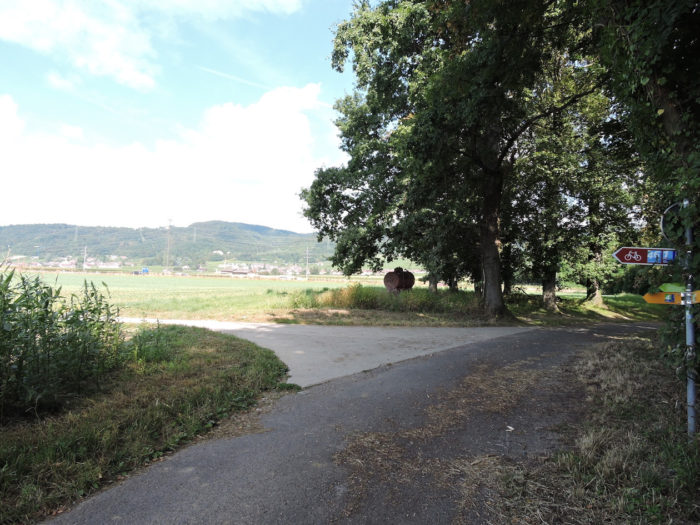 |
| Between the cornfields and orchards, the Via Jacobi traces its route, like an asphalt river winding through crops and groves, while the highway, like a tempestuous sea, roars on the horizon. |
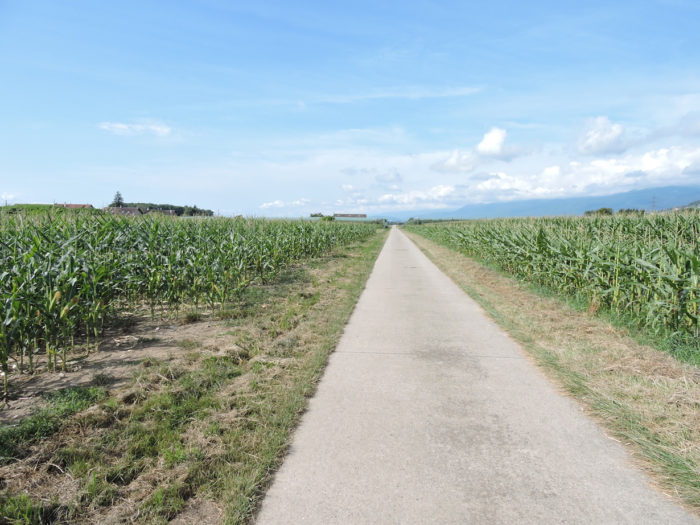 |
 |
| As the highway rest area looms on the horizon, the path diverges, turning away from the mechanical bustle to carve a path towards the tranquility of the En Convers train station. |
 |
 |
Section 2 : Among the winemakers of La Côte

Overview of the route’s challenges : a route without any difficulty.

|
The road unfolds with an almost musical fluidity until it reaches the modest En Convers station, a cherished oasis for the artisans of the land, a bustling point of passage animated by local market gardeners, whose activity seems synchronized with the comings and goings of trains.
|
 |
 |
| At this point, the Via Jacobi gracefully inclines under the imposing weight of the railway tracks, traversing a semi-industrial area that bears witness to the economic vitality of the region. |
 |
 |
The route then moves towards a roundabout where the symbolism of viticulture unfolds with grace. In the canton of Vaud, two wine regions emerge with unequalled grandeur: Lavaux, between the shimmering shores of Vevey and Lausanne, and La Côte, which proudly extends across the landscape of the day.
|
 |
 |
| Nearby, the winegrower village of Bursinel displays its charms, offering a timeless escape amidst vineyards that stretch to the shores of the sparkling lake. However, the sons of labor are not only vine growers in these coastal lands. Indeed, faced with such a spectacle offered by the calm waters of the lake, it is not surprising that even those who do not instinctively feel the call of the land have been seduced by the magic of these places. |
 |
 |
| In the midst of the village, a road descends into the vineyards overlooking the lake. On days of great weather, the spectacle here is worth the detour. |
 |
 |
The route then reveals the castle, like a historical jewel nestled in a green setting, bearing witness to the splendor of the 19th century. Whispered legends even evoke the ephemeral presence of Churchill, whose silhouette would have once haunted these places imbued with elegance and refinement. Every stone of this building seems to whisper the secrets of a glorious past.

|
Continuing its journey, the Via Jacobi infiltrates the heart of the village, where the vine and its valiant artisans reign supreme. Everything here exudes cleanliness and serenity.
|
 |
 |
One might as well unpack their bags here, don’t you think?

| Shortly after leaving Bursinel behind, the entrance to Dully emerges on the horizon, signaling the imminent arrival in this jewel nestled on the beautiful vineyard hillside. These two villages, merged like links in a chain, gracefully stretch from the serene shores of the lake to the outskirts of their picturesque hamlets, such as St Bonnet and Bourg d’Amont. |
 |
 |
| Dully then reveals itself in a unique light, like a painting where the delicate nuances of traditional winegrower houses blend with the discreet opulence of prestigious villas that punctuate the landscape. The road, like a capricious muse, begins its journey through the alleys of St Bonnet, between the benevolent shade of the vines and the sweet scent of flowers, an enchanted interlude in this haven of serenity. |
 |
 |
| Gracefully skirting the elegant facades of contemporary villas, the road continues its dance through the meanders of Bourg d’Amont, offering travelers a succession of breathtaking lake panoramas. |
 |
 |
| Then, like a golden thread woven by the skilled fingers of time, the road moves with measured solemnity towards the center of Dully. Dully, while retaining its provincial charm, remains imbued with a modesty contrary to the ostentatious opulence that characterizes some upscale villages in the Geneva suburbs. |
 |
 |
A few steps away, in the benevolent shadow of a secret garden, stands the proud silhouette of an ancestral manor, once a silent witness to the splendors of the 15th century. Transformed over the centuries into a hybrid structure, where the grace of Gothic style intertwines with the elegance of the Renaissance, this double castle stands like an impassive guardian of the mysteries buried in the folds of time. However, its enchanting aura remains out of reach, hidden from the gaze of passersby by the impenetrable walls of private property.

| Let’s now move on to another time of the year, early spring when the leaves begin to grow on the trees.
Here, the journey transforms, taking less trodden paths, leaving the vineyards to delve into the verdant meanders of the countryside and the rigor of the woods. A road unfolds with serene nonchalance, descending in graceful curves through the fields, delicately skirting the outskirts of the village. |
 |
 |
| Lower down, where the murmur of streams mingles with the whispers of the wind, the Via Jacobi fades into the welcoming shadow of the Lignière woods. The path becomes a silver thread that disappears among the trees, while wild grasses dance to the rhythm of crystalline streams, caressing the ground with their wild gentleness. It’s an intoxicating tableau, a symphony of greenery where each leaf plays a note of music, and each stream a gentle whisper of nature. |
 |
 |
| The Dullive brook stands in the way, offering its bridge as a link between two worlds. The bridge becomes a sacred threshold, a gateway to the wild world. |
 |
 |
| Further on, the path plays with altitudes, climbing and then descending with the grace of a prima ballerina. |
 |
 |
|
Around a bend, the path crosses the Lavasson stream, like a lover found again in the tender embrace of the woods. The water’s murmur becomes more insistent, more enchanting, as if inviting one to follow its course to the end of the world. The trees lean in to better listen to this gentle melody.
|
 |
 |
| Then, the path weaves between the trees, sliding like a silver snake along the hillside, following the carefree course of the Lavasson. The deciduous trees stand tall, their branches intertwining in a vegetal tangle, while the beeches rise towards the sky like immutable sentinels. It’s a majestic scene, where nature unfolds all its splendor, offering the traveler the grand spectacle of their own insignificance. |
 |
 |
| Around a bend, where the trees are less dense, the path widens, as if to better welcome the walker. Shortly after, at the place called Les Hiboux, the path leaves the stream behind, climbs a little higher, and broadens on compact earth. |
 |
 |
Section 3 : The dreary crossing of Gland before a new small miracle of nature and man

Overview of the route’s challenges : a route without any difficulty.

|
The path still winds through the heart of the forest, where trees intertwine in a millennia-old dance. Footsteps softly echo on the dirt path, each step a note in the symphony of nature.
|
 |
 |
Around a bend, the landscape opens up to an expanse of orchards and vineyards, like jewels scattered in the landscape. The path will alternate between grass and beaten earth, amidst orchards, vineyards, and fruit trees before reaching the outskirts of Gland. And there, majestic, stands Mont Blanc, like a king watching over his realm of eternal ice, an immutable sentinel in the dance of the seasons.
|
 |
 |
| It’s a breathtaking tableau, a living fresco where the colors of the sky, the nuances of crops, and the sparkling reflections of the lake mingle. Enjoy it. For your life will change a bit. Because the path is not just felicity and bliss. As you approach Gland, the atmosphere changes, becoming charged with a subtle tension, an almost palpable agitation. |
 |
 |
| The Via Jacobi emerges much further into the Montoly district, in the heart of this ever-moving city. |
 |
 |
|
A word about Gland, this city with multiple faces. Once a modest village, it has transformed into a cosmopolitan metropolis, attracting souls in search of fortune and fame. Reflecting a devouring ambition, the residential neighborhoods sprawl like precious fabrics around the shimmering lake. This is where the elites, the celebrities reside, hidden behind opaque facades, away from prying eyes and city rumors. You won’t see these people lurking near the train station. In fact, the wealthiest among them live near the lake, in an area rarely accessible to walkers. The Via Jacobi disregards them. It’s better to say that the local authorities did nothing to let the route pass closer to the lake.
And finally, the road leads you to the train station, an anchor point of this ever-moving city. The suburb stretches out, anonymous and characterless, a transitional backdrop in the grand theater of existence.
|
 |
 |
| Pay special attention to this place! Avoid passing under the station. The routes have been redrawn. Previously, the Via Jacobi crossed the rails, traversed the large suburb, then reached the Côte aerodrome before reaching Prangins. A monotonous route, mainly on sometimes crowded roads.
A huge thank you to the organizers of the Via Jacobi 4 for proposing an improved route. However, a simple sign, as small as a pocket handkerchief, shows the change. A larger sign would have been welcome. Without clear indications, it is easy to get lost. |
 |
 |
| The Via Jacobi nestles for a while along the rails, in this industrial grayness, where sadness seems to have taken up residence. |
 |
 |
| But as it is blocked by the industrial zone, it detours towards the meadows. |
 |
 |
| After a fairly long straight stretch, boring in every way, it turns at right angles and returns towards the railway track. |
 |
 |
| And there, like a traveler from the past, it runs alongside the railway tracks, until the edge of the woods where the « Toblerones Path » stands, a proud vestige of a troubled era. Erected for defense, this fortified line, named for its concrete blocks evoking the famous chocolates, recounts the saga of more than 2,500 concrete blocks, standing like silent guardians between lake and mountain. And today, this path, a witness to bygone times, stretches for over ten kilometers, offering a spectacle that is both majestic and mysterious. |
 |
 |
| In its unyielding momentum, the Via Jacobi slips between the ancient woods, enveloping itself in the soothing symphony of the singing river. Under the protective canopy of majestic beech trees, it moves forward, sometimes proud and dominant, sometimes a humble disciple of sovereign nature, where each step resonates like a verse whispered by time itself. This magical stroll is a one-kilometer journey along these ramparts of another time, which nature, with its ineffable magic, has patiently invested with moss and ivy. War can be divine sometimes. |
 |
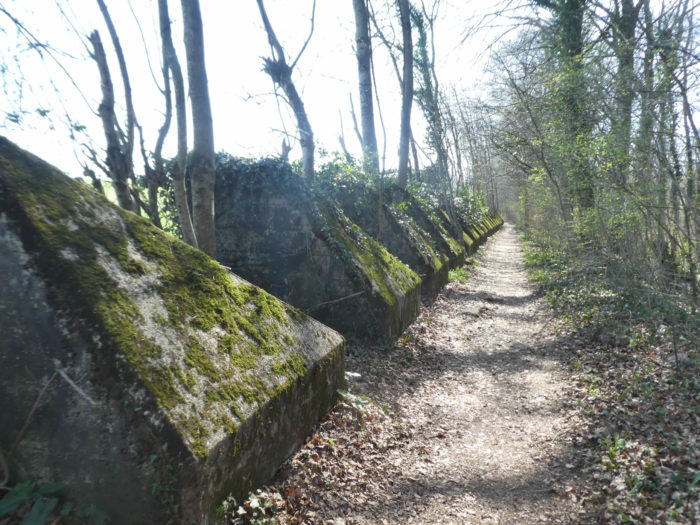 |
| The path continues under the beech trees, slightly overlooking the Promenthouse River, sometimes visible under the trees, sometimes calm, often a bit more agitated. |
 |
 |
| Further on, the path approaches the majestic Guigier farm, at the place called Les Avouillons. This large farmhouse dates back to the end of the 19th century. It is always moving to discover prosperous farms in this green setting, where the landscape seems to have succumbed to the allure of urban development. In this preserved paradise, where the birdsong still mingles with the whispers of the fields, the peasant soul persists, forcefully reminding that this is not the realm of concrete. |
 |
 |
| The walk along the Toblerones comes to an end when it reaches the Côte power plant, near the Swiss Road. |
 |
 |
| At this precise location, the Via Jacobi slips under the bridge and rises by a staircase to the level of the road. Special vigilance is required here, as it is easy to be tempted to follow the yellow arrow, which indicates the direction of the Via Jacobi 3. However, the Via Jacobi 4, on the other hand, continues its path in the opposite direction, on the bridge. |
 |
 |
Section 4 : A small piece of lake and a beautiful castle

Overview of the route’s challenges : a route without any difficulty.

|
After crossing the bridge over the Promentouse, the Via Jacobi, like a skilled artist, subtly merges for about a hundred meters into the ribbon of the Swiss Road before withdrawing again into the mysterious woods. There, in this sanctuary of greenery, where the whispers of the foliage blend with the gentle song of the river, the traveler’s soul succumbs to the serene invitation of the path. .
|
 |
 |
It is here, once again, that a delicate stroll unfolds along the winding path, amidst protective foliage, within reach of the now hidden river.
|
 |
 |
| Not far from there, at the edge of this enchanting haven, lies the mystery of the Imperial Domain golf course. For those initiated into wild enchantment, an unexplored trail beckons, but your destiny, traced by the Via Jacobi, does not lie along this detour. |
 |
 |
| The Via Jacobi persists a little longer in the secret folds of the woods before revealing itself, like a goddess unveiling her splendor, on the vast plain where the labors of the Promenthoux market gardeners stretch out. |
 |
 |
|
A road, paved with history and dreams, then leads you to the majestic complex of the Priory in Promenthoux.
|
 |
 |
| Here, history stands like a benevolent specter, surrounding the imposing vestiges of a once prosperous village, whose glory was caressed by the breath of the Middle Ages. |
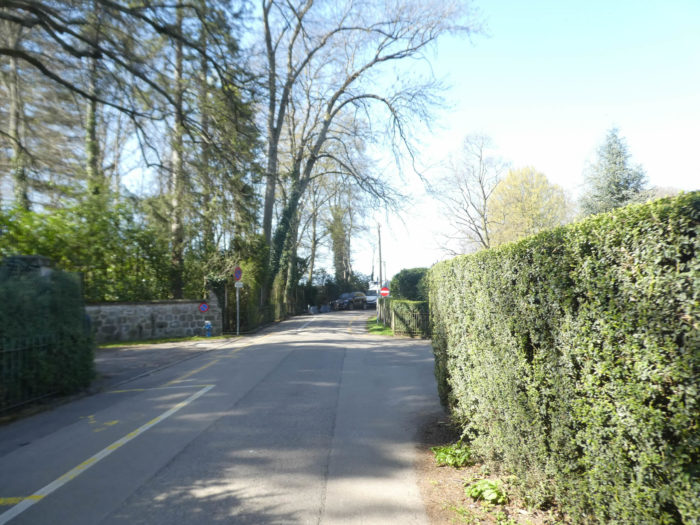 |
 |
| It’s an idyllic vision that unfolds before your eyes, a blend of noble farms and an imposing patrician mansion, silent witnesses to a glorious past now engulfed by the twists of time. Every stone, every sigh of these places, whispers to the traveler’s soul the grandiose tales and forgotten legends of a village whose fleeting beauty remains immortal. |
 |
 |
| The road gracefully winds along the lake, offering a fleeting moment of closeness with its crystalline waters. It’s a moment to savor, as it’s the only instant of the journey where one can be enveloped by the majesty of the lake. Yet, this ephemeral privilege is quickly overshadowed by a less romantic reality: you were warned that this stretch, from Rolle to Geneva, does not yield to the steps of walkers but submits to the mercantile ambitions of developers. The contrast between fleeting tranquility and the voracity of real estate development is sharply evident. |
 |
 |
| As you move away from the lake, the road gracefully ascends through the meadows, occasionally revealing the proud silhouettes of sumptuous patrician mansions. Soon, the imposing profile of the Prangins Castle emerges on the horizon, rising like an ageless guardian of the surrounding lands. History, palpable in every stone, murmurs the tales of a glorious past, where splendor and intrigue intertwine. |
 |
 |
| The road now winds its way among the first houses of Prangins, perched above the lake, near a psychiatric clinic, lost in the verdant foliage. You are now just forty minutes’ walk from Nyon, and yet the atmosphere seems to have subtly changed. An aura of mystery hangs in the air, woven from the secrets of these places where beauty and mystery coexist. |
 |
 |
| The Via Jacobi continues its journey, heading with determined elegance towards the castle perched on its modest hill. Up there, it reigns like a jewel carved from rock, a silent sentinel watching over the surrounding lands. Its imposing presence inspires admiration, while legends and stories intertwine to bestow upon it a timeless aura. |
 |
 |
| Climbing the steep slope that leads to this bastion of history is to follow in the footsteps of the great travelers who have trodden these lands. It is also to claim a share of a prestigious heritage, a testament to the emotions and aspirations that have crossed the ages. One cannot help but think with a pride tinged with respect that even Mozart himself, that genius among men, made a stop in Prangins during his journey through Switzerland. His notes still resonate in memory. |
 |
 |
 |
 |
| Since the Middle Ages, an imposing fortress, once the stronghold of the Dukes of Savoy, majestically stood here, defying the passage of centuries. But time, inexorable, gradually erased its contours, and it faded into oblivion. In the year 1723, a Parisian banker of Swiss origin named Louis Guiguer laid the foundations of the current castle, thus breathing new life into these dormant lands. Even Voltaire, the brilliant philosopher of the Enlightenment, stranded in the mazes of exile, found refuge here for a time, leaving the echo of his thoughts to wander within the stone walls. Decades passed, the castle evolved under the care of the patricians who guarded it with pride and solemnity. Then came the year 1974, a turning point in its millennial history, when the estate, restored to all its former splendor, was offered in homage to the Swiss Confederation, destined to become a sanctuary dedicated to Swiss history, art, and culture, thus revealing the secrets buried between the thirteenth and nineteenth centuries. Like a phoenix rising from the ashes, the Castle rose, no longer as a mere witness to the past, but as a vibrant symbol of Switzerland’s life and cultural richness. |
 |
 |
| Continuing its journey, the Via Jacobi ventures through the maze of a vegetable garden, where the graceful vegetables of yesteryears flourished, silent witnesses to age-old traditions. Here, in the heart of this peaceful borough, inhabited by nearly 4,000 souls, it reveals its picturesque charms, offering the peaceful harmony of authentic alleyways. |
 |
 |
| Gracefully descending along the ancient facades of the village, the Via Jacobi begins an enchanted ballet, weaving invisible ties between the dwellings of the past and the present. Then, with a graceful movement, it ascends on the other side, making its way among the recent developments, where discreet luxury vies with sober elegance. There, hidden from prying eyes behind thick barriers of meticulously trimmed thuja hedges, lies the secrets of a preserved modernity, protected from view by thick barriers of thuja hedges as if going to Sunday Mass. |
 |
 |
Section 5 : Crossing Nyon before returning to the countryside

Overview of the route’s challenges : a route without any difficulty.

|
In the tranquil harmony of landscapes where Prangins and Nyon almost blend into one breath, a subtle transition occurs. A few scattered vineyards, proud sentinels towering majestically over the lake, mark the threshold of this passage. Like silent guardians of an invisible border, they signal the entry into a new universe.
|
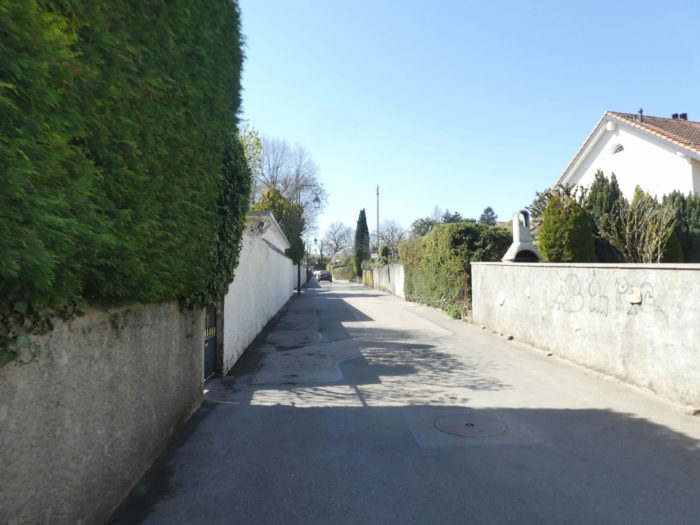 |
 |
| A winding road diverges shortly after, descending with infinite grace to embrace the curves of the railway. |
 |
 |
A narrow, tar-paved path then traces along the edge of the track, delving further into the mysteries of the region. Like a blue vein on the earth’s skin, it meanders, revealing to those who traverse it the well-guarded secrets of these less enchanting lands.
|
 |
 |
| A fleeting moment of separation, the path momentarily veers away from the railway to intersect with the road by the murmur of the Asse stream, before gently sloping up towards the station with an almost solemn grace, like a respectful bow to the history of the place. |
 |
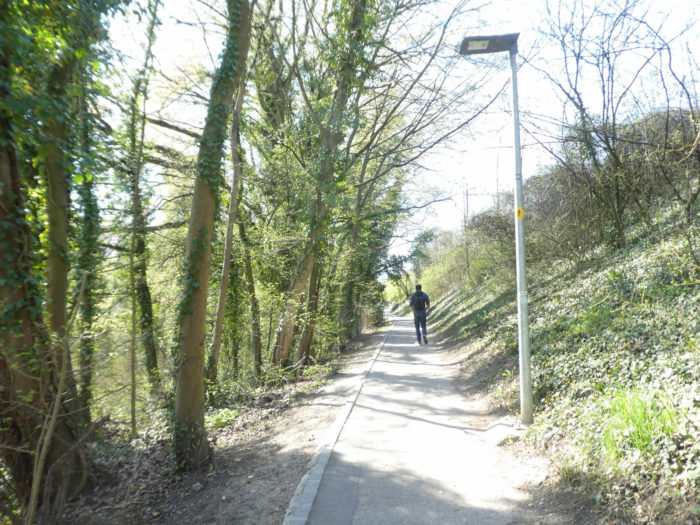 |
|
Like a lament whispered by the winds of travel, the Via Jacobi makes its way towards the station, following the meanders of the rails with tranquil determination.
|
 |
 |
| For the pilgrim, Nyon (20,000 souls) will only reveal itself through the prism of the station district, unless one pauses in these places. Like a nymph of modern times, Nyon in Vaud is turned towards Geneva, captivated by the magic of the neighboring city. Many inhabitants work in Geneva. Thus, the Via Jacobi continues its course, passing by the station like a silent procession, before getting lost in the maze of the nearby suburbs. |
 |
 |
| Further on, it prepares to leave behind the monotonous tumult of the railway tracks and the uniform facades of the suburbs to venture into the intimate tranquility of a woodland. |
 |
 |
| There, in this sanctuary of greenery, peacefully winds the River Boiron de Nyon, a gem not to be confused with its namesake in Morges. This transition, this metamorphosis of the landscape, is as if the soul of the traveler enters another world, a world where time seems to slow down to allow for the sober contemplation of nature. |
 |
 |
| A steep path then makes its way from the riverbanks, gracefully climbing through the woodland. Each step resonates like an ode to nature, an ode to raw beauty. It’s a true sylvan ballet playing out under the foliage, an eternal dance between light and shadow. |
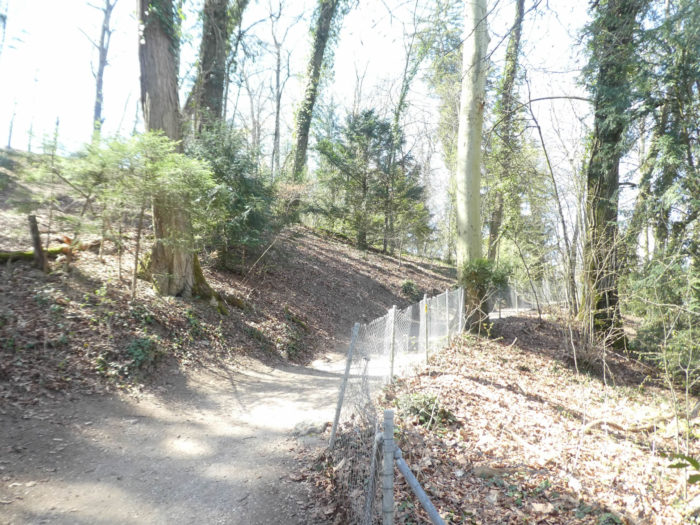 |
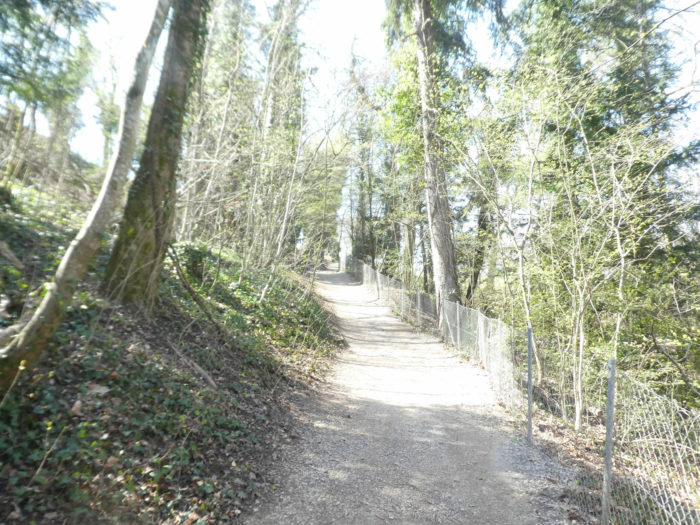 |
| Emerging from the woods are the familiar contours of the place called Bois-Bougy, a rustic enclave where a grand farm stands majestically. The age-old architecture of this rural abode seems to bear witness to centuries past, to times when nature still dictated its sovereign rule. |
 |
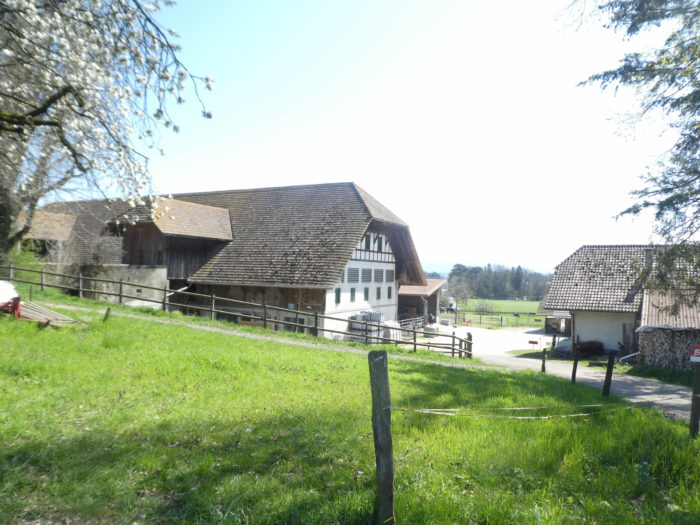 |
| Yet, despite this foray into a bygone world, the landscape remains rooted in modernity. The vast green expanses stretching as far as the eye can see are not the realm of cattle herds but of crops. And among these fertile lands proudly stands the elegance of equines, the noble horse, a symbol of grace and power. |
 |
 |
| From Bois-Bougy stretches a straight road, like a ribbon of asphalt delving into the wooded setting. This modern artery contrasts with the immutable tranquility of ancient woods. It’s as if two worlds, two epochs, coexist without colliding, in a delicate and harmonious balance. |
 |
 |
| At the end of this road, the Via Jacobi stands, inviting adventure, exploration of the forgotten paths of Bois Neuf. |
 |
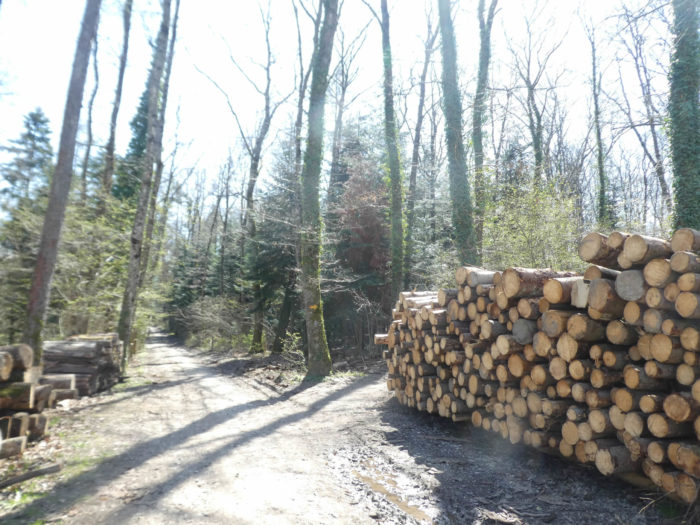 |
| There, a winding path meanders through the density of trees. There’s a particular atmosphere here, imbued with the majesty of ancient oaks, immutable guardians of this vegetal sanctuary. Beeches, meanwhile, stand as gentle echoes, offering their benevolent shade to travelers. And among these wooden giants, spruces stand like sentinels, watching over this green haven with an almost tangible solemnity. |
 |
 |
Section 6 : In the Vaud countryside
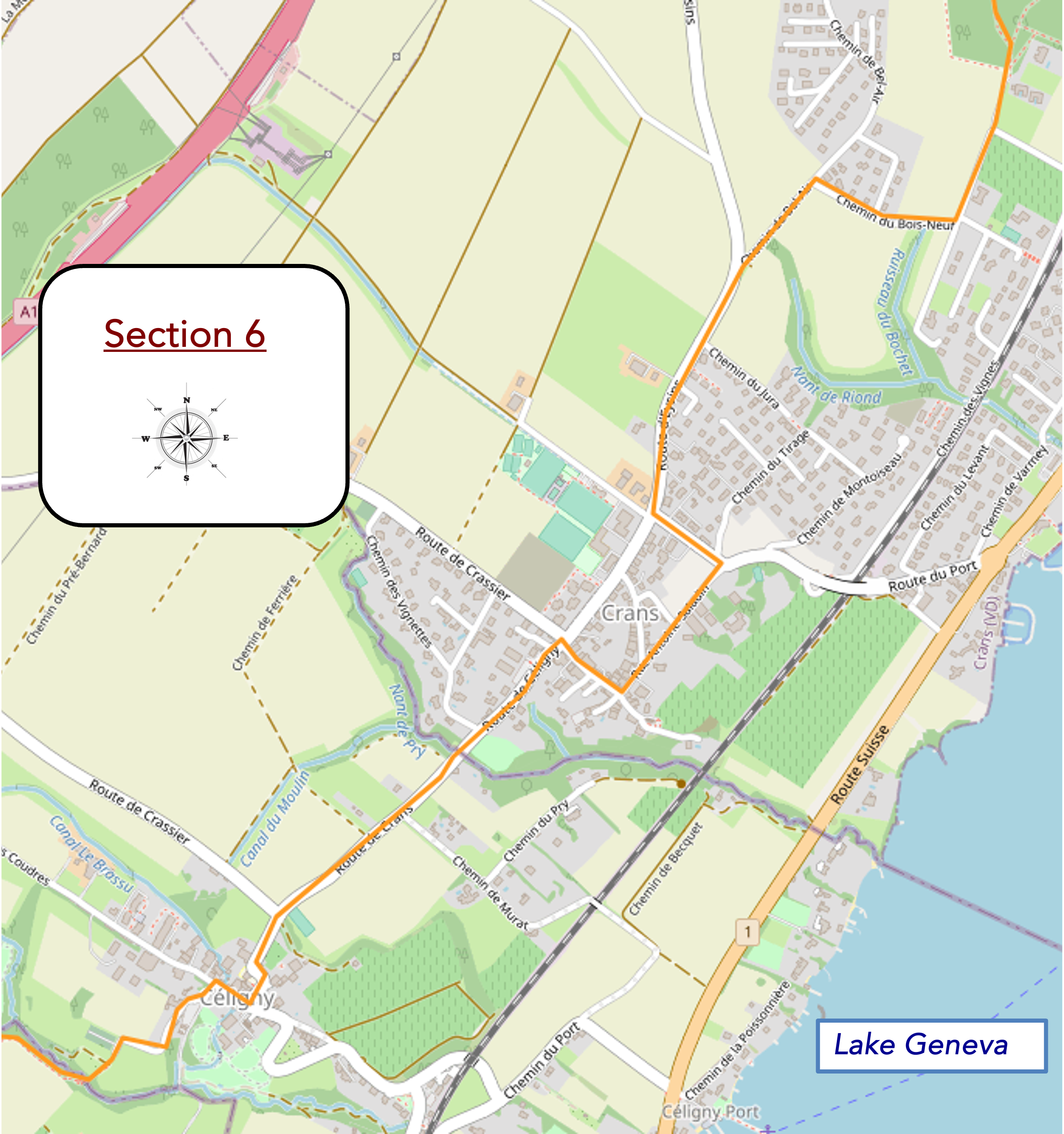
Overview of the route’s challenges : a route without any difficulty.

|
At the edge of the woods, the Via Jacobi emerges into the bright daylight, finding the asphalt road again in the village of Bois Neuf.
|
 |
 |
It is here that the route intersects with the material world, where wealth is displayed in majestic residences embracing the breathtaking view of the shimmering lake. While the affluent settle first, building their havens of peace, others settle for recent developments scattered across the plain, devoid of the lake view but taunting the peaks of the Jura that loom in the distance.
|
 |
 |
| Between rows of vineyards and the contours of the new development, the road winds, caressing the flank of the Jura. A symphony of contrasts presents itself to the traveler, between fertile plots and still virgin lands, where urban progress blends with pastoral tranquility. |
 |
 |
| At the exit of the development, the Via Jacobi turns at right angles onto a sidewalk towards Crans. |
 |
 |
|
The village takes shape just a few steps away, an oasis of charm and harmony nestled in the setting of its old stones.
|
 |
 |
| At the village entrance, don’t be surprised. Via Jacobi 4 turns left towards the castle, because there is another path that goes to the right. Attention! |
 |
 |
| It skirts a large quadrilateral of greenery… |
 |
 |
| … before passing in front of the castle esplanade. A venerable building, erected at the end of the 18th century, stands proudly, a witness to bygone eras. Classified as a cultural property of national importance, the castle is the seat of a vast vineyard estate. Its meticulous restoration has preserved its former majesty, conferring upon it the status of a national cultural treasure, a symbol of a glorious past. |
 |
 |
| Continuing its journey, the Via Jacobi unveils the buried treasures of Crans, a village where time seems frozen in the splendor of its old houses and gushing fountains. Perched on the heights, this winegrowing village overlooks the lake with a benevolent gaze, a testament to a secular tradition now embraced by the bustle of modernity. Ancient customs now mingle with the excitement of newcomers drawn by the economic dynamism of the Lake Geneva basin, pulsating to the rhythm of Geneva. |
 |
 |
| At the village gates, Via Jacobi turns towards Céligny, its winding path following the main road as it discreetly crosses the modest Nant de Pry stream, hidden in the wild grasses stretching as far as the eye can see. |
 |
 |
| A narrow strip of land timidly stretches along the road before making its way behind a protective hedge. Like a discreet sesame, this hidden path seems to invite travelers to adventure. |
 |
 |
| Far from being a mere detour, this ephemeral path offers much more than just an escape from the traffic. It’s not that the traffic is heavy, but this short path allows you to avoid the road, and above all, to remember that beneath it lies a magnificent lake that is rarely enjoyed. |
 |
 |
|
Soon, the path rejoins the road at the entrance of Céligny, revealing to travelers the magnificent Garengo Castle. Like a jewel from the 17th century, this lordly residence stands proudly, enveloped in the setting of its gardens, crossed by the delicate murmurs of the Brassu stream. Nearby stands another exceptional residence, the Petit Elysée, once the home of the Russian virtuoso, Nigita Magaloff. All these houses, steeped in history, are designated as national cultural treasures.
|
 |
 |
| The commune of Céligny is quite special. It’s somewhat anachronistic, but it’s still an exclave of the canton of Geneva within the canton of Vaud. And to make it even more interesting, one of these enclaves also includes a part of the lake. This is the whole history of Switzerland, with all the divisions that have occurred over time. Through its picturesque alleys, imposing bourgeois residences hide behind protective gates, testifying to a lavish past and discreet nobility. |
 |
 |
Even for the more modest, the picturesque charm of the village remains intact, amidst the stone fountains that dot the streets, offering their clear but non-potable water.
|
 |
 |
The soft murmur of the Brassu stream accompanies the steps of travelers, a relic of a time when agriculture and viticulture reigned supreme in this blessed region. But the specter of Geneva, so close, has inexorably shaped the destiny of these lands, gradually transforming them into residential havens.

|
The Via Jacobi finally escapes from Céligny, heading towards the two cemeteries, the old and the new, which stand like silent sentinels, guardians of ancestral secrets.
|
 |
 |
| A narrow path then reveals itself, winding towards the Brassu stream, inviting travelers to a meditative halt before leading them back under the protective cover of the majestic beech trees. |
 |
 |
Section 7 : Gradual return to the lake

Overview of the route’s challenges : a route without any difficulty.

|
At the top of the stairs, where the stone blends into the undulating greenery of the forest floor, the trail unfolds, beckoning exploration beyond familiar contours.
|
 |
 |
| In this tapestry of history woven through the centuries, the path soon intersects the majestic domain of Bossey Castle, a structure exuding the charm of the eighteenth century. |
 |
 |
Under the auspices of Madame de Staël, the renowned intellectual and mistress of Coppet Castle, this splendid residence of Bossey Castle was acquired, driven by maternal instinct for her son. Over time, this architectural gem has traversed ages, changing hands repeatedly, embracing diverse destinies. It served as a refuge for an American girls’ college, a retreat for Polish souls during the harsh turmoil of the Second World War, before becoming the sanctuary of an ecumenical center. Today, in continuity with this ecumenical calling, the castle flourishes as a haven of knowledge, hosting prestigious conferences, a hotel with antique charm, and a restaurant where flavors of history and gastronomy intertwine. At the heart of this historical gem, the estate stretches, bathed in tranquility, its majestic park extending around a pond with ever-changing reflections.
|
 |
 |
| From there, a wide path, like a living artery, circles part of the ramparts that delineate the property, bearing witness to past grandeur and the perpetuity of ancestral traditions. |
 |
 |
| At the exit of this grand estate, not far from a tower once warlike, now transformed into a residence of aristocratic elegance, stands a wooden sign, a discreet sentinel that demands your attention. You might be on your way to Coppet, but do not succumb to the allure of this direction. Instead, let yourself be guided by Via Jacobi 4, a path you must follow, faithful and intrepid. |
 |
 |
|
An imposing alley, like a beaten earth path, gracefully stretches downhill, flanked on either side by dense hedges, sheltering majestic deciduous trees. It descends with natural elegance until it veers away, escaping the grasp of trees to venture into the surrounding countryside.
|
 |
 |
| Here, the path, like a river meandering through the countryside, suddenly veers off, facing nascent rapeseed fields and promising orchards. . |
 |
 |
From this stretch, the view majestically opens up to the lake, like an azure mirror reflecting the grandeur of the skies, while the Alps proudly rise on the horizon, their snow-capped peaks caressing the firmament.

| Further on, the Via Jacobi inclines once more, this time gracefully, onto an asphalt road. It bends to the whims of the landscape, following the rhythm of time and seasons. |
 |
 |
| And thus, the road inevitably leads to Founex, like a storyteller guiding their listeners towards an expected conclusion. |
 |
 |
| The Via Jacobi, like a vital vein, meanders through the winding streets of the village of Founex, threading its alleys like beads on an infinite necklace. From the first steps, the magnitude of this borough seizes you. Its 3,800 inhabitants animate its arteries. It is easy to guess that the majority of its residents do not derive their livelihood from the surrounding farmlands, but rather from the promising horizons of Geneva. |
 |
 |
| You traverse a main street, where centuries seem to have been frozen in the marble of ancestral fountains. Some of them, precious relics of the eighteenth century, present themselves to you as silent witnesses of the passing time. Through their melodious murmur, they recount forgotten tales, the stories of those who trod these same cobblestones centuries ago. |
 |
 |
| But life in Founex is also about wine flowing abundantly, like an intoxicating symphony for the senses. |
 |
 |
| Yet, when you leave Founex, the route takes an abrupt turn, confronting you with a harsh stretch of road, where fatigue seems to overshadow pleasure. It is here, in effort and perseverance, that sometimes the true essence of the journey lies, in the struggle against adversity and the conquest of oneself. |
 |
 |
| And when finally, the sign announcing Coppet looms on the horizon, do not succumb to the temptation to believe you have reached your destination. The Via Jacobi, like a capricious guide, leads you even further. It invites you to dance one step after another, through the road that leads to Commugny. |
 |
 |
| So, you will continue straight ahead on the sidewalk of Route du Jura. |
 |
 |
| Further along, you pass by the College of Terre Sainte, which must gather all the municipalities of the region, judging by its importance. |
 |
 |

Section 8 : Returning to the lake

Overview of the route’s challenges : a route without any difficulty.

| After crossing the threshold of the college, the Via Jacobi skirts the college’s sports complex. |
 |
 |
| Then, the road gently slopes up into the heart of the village, guiding the walker to the church square with ease. |
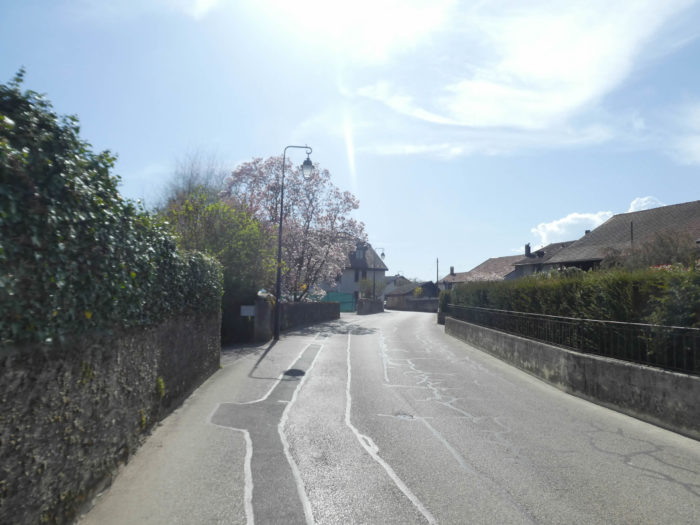 |
 |
Steeped in history, the church stands as a silent guardian of centuries past. Rebuilt in the 15th century on the foundations of a Romanesque church, it embodies continuity amidst the tumult of time. Formerly dedicated to St. Christopher, it now bears witness to the diversity of beliefs, proudly embracing its function as a Reformed temple. Simple in its elegance, both inside and out, it invites reflection, if not contemplation.
|
 |
 |
| The Via Jacobi continues its way, straight and indomitable, resisting the allure of Coppet looming in the distance. A choice presents itself: continue towards Geneva or be tempted by the tranquility of this preserved town. But such is the nature of the journey, an eternal oscillation between the desire to discover and the need to pause. A discreet yet present sign points towards the port of Coppet, just twenty minutes from here. For there are moments when the body demands rest, when the journey becomes a destination in itself. |
 |
 |
| The journey towards Coppet begins behind the church. Like an initiatory passage, this road embarks on its journey, gently descending towards the unknown, towards Coppet, like a precious treasure hidden in the folds of the landscape. |
 |
 |
|
As the descent progresses, the road delicately cuts through the winding stream of the Doye, like a subtle stitch on the fabric of the surrounding nature. The water murmurs in harmony.
|
 |
 |
| Soon, the small road joins a more imposing thoroughfare, originating from Founex, leading to the small station of Coppet. Within a leisurely ten-minute walk lies Coppet, like a jewel nestled in the enchanting backdrop of the lake shores. Each step, each heartbeat, draws one closer to the vibrant heart of this city with timeless charm. |
 |
 |
| The descent towards the lake shores unveils a spectacle worthy of grand historical moments. The castle, a proud relic of the past, stands as a guardian of ancient secrets, bearing witness to the bygone splendors of a bygone era. Here resonate the echoes of Necker’s life, the finance minister of Louis XVI, whose acquisition of the castle marked a turning point in its history. But it is primarily the memory of his daughter, Madame de Staël, that permeates these walls with her rebellious spirit and insatiable quest for freedom. Condemned to exile by Napoleon, she found refuge in Coppet, transforming this place into a sanctuary of dissenting thoughts and unbridled creativity. For a time, Coppet was the stage for fierce resistance against oppression, a beacon of light amidst imperial darkness. But like a fleeting breath, all of this vanished with the death of Madame de Staël in 1817, leaving behind an immortal legacy, a glimmer of eternity in the twists of history. |
 |
 |
| Coppet, populated by its 3,100 souls, rests like a jewel on the edge of the tranquil waters of the lake. Its feet dip into silvery reflections, its narrow winding streets reveal a past rich in legends. Majestic arcades, historic residences with stones weathered by time, bear witness to a bygone era never forgotten. Some of these houses, dating back to the 16th century, tell in their own way the tumultuous history of Coppet, the story of a town pulsating to the rhythm of seasons and the tides of existence. The temple, once a Gothic church, stands like a spiritual beacon, guardian of souls and secrets buried within the folds of age. |
 |
 |
And there, around a corner, with bated breath, the lake reveals itself once more, majestic and infinite in its splendor. Coppet then unfolds like a living tableau, a work of art in perpetual metamorphosis, where each moment, each frozen moment in the eternity of the present, becomes an ode to life, to ephemeral yet timeless beauty.

Accommodation on Via Jacobi
- Eliane Trurn, Ch. Peccaudès 6, Dully; 021 824 10 03; Guestroom, dinner, breakfast
- Auberge de Dully, Place du Village 9, Dully; 021 824 11 49; Hotel***, dinner, breakfast
- Gîte communal, Chemin de Montoly 1, Gland; 079 578 01 57; Gîte, cuisine
- Hôtel de la Plage, Ch. de la Falaise 3, Gland; 022 364 10 35; Hotel*, dinner, breakfast
- Hôtel Glanis, Route de Begnins 2, Gland; 022 354 16 20; Hotel***, dinner, breakfast
- Famille Andrey, Route du Curson 19a, Prangins; 022 362 04 82/077 496 33 53; Accueil jacquaire, dinner, breakfast
- Auberge communale, Prangins; 022 361 25 75; Hotel*, dinner, breakfast
- Hôtel La Barcarolle, Route de Promenthoux, Prangins; 022 365 78 78; Hotel***, dinner, breakfast
- David Kohler, Ch. des Saules 10B, Nyon; 076 379 38 55; Accueil jacquaire, dinner, breakfast
- B&B Baumgartner Vreni, Avenue du Bois-Bougy 9, Nyon; 022 361 25 03; Guestroom, breakfast
- B&B Bussy, Route de l’Etraz 34B, Nyon; 022 361 25 03; Guestroom, breakfast
- David Kohler, Ch. des Saules 10B, Nyon; 022 566 19 70/078 734 78 91; Guestroom, breakfast
- B&B Baumgartner Samuel, Ch. Du Bois Bougy, Nyon; 022 361 34 52/079 242 80 66; Guestroom, breakfast
- Nyon Hostel, Chemin des Plantaz 47, Nyon; 022 888 12 60; Hotel, dinner, breakfast
- Château de Bossey, Bogis-Bossey; 022 960 73 00; Hotel, dinner, breakfast
- Carlos Conza, Route de Céligny 6B, Founex; 079 785 10 84; Accueil jacquaire, dinner, breakfast
- Auberge de Founex, Grand rue 31, Founex; Hotel, dinner, breakfast
- Bernard et Claire Nicolet, Route de Founex 4, Commugny; 022 776 12 08; Accueil jacquaire, dinner, breakfast
- Motel Le Léman, Route de Genève 11, Commugny; 022 776 25 21; Hotel, dinner, breakfast
- Hôtel- restaurant Guillaume Tell, Route de Divonne 10, Commugny; 022 776 11 67/079 436 72 19; Hotel**, dinner, breakfast
- Hôtel d’Orange, Grand Rue 61, Coppet, Coppet; 022 776 10 37; Hotel**, dinner, breakfast
It’s difficult to find accommodation at the end of the stage. You can stop at Commugny if you don’t want to go down to the lake at Coppet. Nevertheless, it’s advisable to book in advance for safety.
Feel free to add comments. This is often how you move up the Google hierarchy, and how more pilgrims will have access to the site.
|
 |
Next stage : Stage 19: From Coppet to Geneva-Cornavin |
|
 |
Back to menu |
























































































